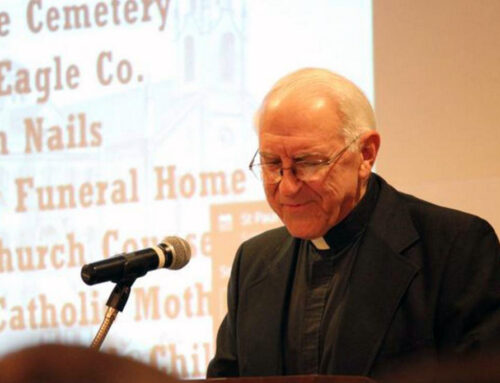Count Berthold von Imhoff was a famous painter of religious art works. He was born Jan. 14, 1868, in Karlsruhe, Germany. At age 12, he started studying at various European art schools including Oberwinter, Halle-an-der-Halle, and the art institute at Karlsruhe, Baden. In 1884, Imhoff won the Art Academy Award of Berlin for his painting The Glory of Emperor Frederick. $3000 was offered for the painting, but he refused, and the painting is now on display at the Lloydminster Cultural and Science Centre in Lloydminster, Saskatchewan, Canada. At age 20, Imhoff began studying figure work at the art academy at Düsseldorf.

In 1891, Berthold Imhoff married Matilde Johner, the daughter of Joseph Johner, who was one of his teachers at Bonndorf. Berthold Imhoff began to feel oppressed by European society, and decided to move to North America. His family settled in Reading, Pennsylvania where he established an art and fresco business.
Below: Count Berthold von Imhoff’s home during his stay in Reading between 1900 and 1913 (Corner of 11th and Green).

During the time he lived in Reading, approximately 1900-1913, he was a member of St. Paul’s Parish. He painted many churches in the area, and the 1908 postcard below shows some of his work in St. Paul’s Church.
Below: St. Paul’s R.C. Church Murals by Count Berthold von Imhoff.


The 1909 book Historical and Biographical Annals of Berks County Pennsylvania by Morton Montgomery contains a listing for Berthold J. Imhoff. The excerpt below describes his interior painting of St. Paul’s Church, including the sanctuary shown in the postcard.
… St. Paul’s church, Reading, is his masterpiece. The architecture of the church is Romanesque, and this necessitated rich colors and heavy ornamentation.
Above the main entrance is a picture representing the parable of the Prodigal son. The center of the ceiling shows three large compositions, 12×18 feet, “The Descent of the Holy Ghost,” “The Assumption of the Blessed Virgin” and “The Coronation of the Virgin,” these forming the last three mysteries of the rosary, the preceding twelve being depicted in the painted windows.
There are two other large compositions, “The Adoration of the Magi” and the “Death of St. Joseph”; eight panels, each containing a single figure; small medallions showing the symbols of the rosary and the instruments of the passion.
The sanctuary arch, as is fitting, is marvelous in both execution and design. The main composition is 40×25 feet.
In the center the risen Savior sits enthroned, and on either side but a little below him are the Blessed Virgin and St. John the Baptist. Between heaven and earth is the Holy Spirit surrounded by the cherubim.
On the earth, grouped about the cross, are the apostles and evangelists, Saints Peter and Paul standing a little higher than the others. Other figures appear, all tending to bring out more fully the subject of the whole composition, “The Church of God.” There are about fifty figures in all, and they occupy five of the seven panels.
In each end panel is an angel, one bearing the pillar at which the Savior was scourged, and the other the spear that pierced His side, and the sponge with which they quenched His thirst.
In this work Mr. Imhoff has used the best models, and his historical accuracy is above question. If he left no other work than St. Paul’s, Mr. Imhoff’s fame as an artist would be complete.
The murals in St. Paul’s were destroyed during renovations. However, it’s thought that Imhoff painted the existing Stations of the Cross in the Church.
Imhoff’s fame soon escalated as he travelled the eastern United States painting churches and homes of wealthy industrialists. As the eastern United States began to become an industrial powerhouse, Imhoff decided to move to Canada. Searching for a quiet, peaceful place to work on his art, Imhoff, Matilde, and six of his seven children moved to what is now St. Walburg, Saskatchewan in 1914. Once in Saskatchewan, Imhoff started painting many of the small churches which dot the prairie landscape near his home, often for free or for very little pay.
In 1926, Imhoff completed what some people consider his masterpiece. Imhoff produced the large work which adorns the ceiling of St. Peter’s R.C. Church in Reading, Pennsylvania. Many of the 224 life-sized paintings were started in his studio in Saskatchewan and then transported to Reading where they were then completed by him and his family. The series of canvasses depict 224 life-size saints, martyrs, virgins and other significant Catholics.
Below: St. Peter’s R.C. Church and Murals by Count Berthold von Imhoff.


In all Berthold von Imhoff ended up painting thousands of frescoes and murals in hundreds of churches in eastern Pennsylvania and throughout midwestern Canada and the United States.
Imhoff died of a stroke Dec. 19, 1939, in his studio near St. Walburg, Saskatchewan, Canada at the age of 71, where there is a statue of him today.





Leave A Comment